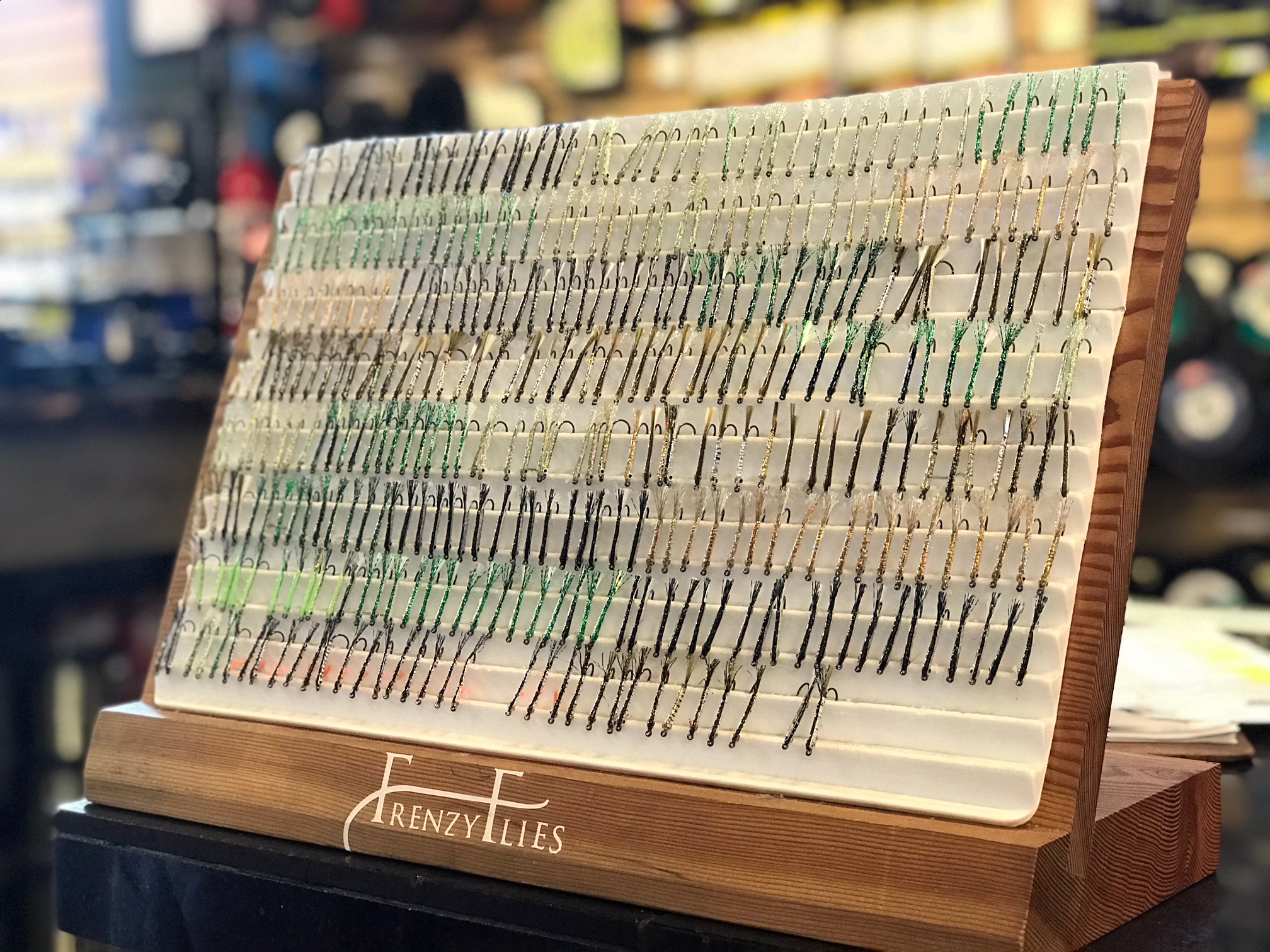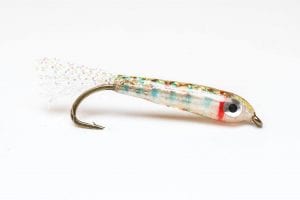OUTLOOK
This is the 3rd week in a row that we having been writing this report (Thursday Evening) with a snowfall warning in effect for Friday. Last week the snow did not hit the Vancouver area as hard as expected but we still got a bunch of wet snow and slush. Again we are on weather watch this week and it is tough to predict what we will see. If you missed it last week we walked you through some of the websites and apps that we use to try and make sense of the weather and river levels so if you missed that check it out in in the link.
This is an interesting time of year and we are hoping for some warmer weather. On the river front we consider this prime time for steelhead on the Vedder River and we have had some solid reports this week. The water is low but there are fish around. Alex has more details in this week’s Vedder report.
For the rest of our rivers, steelhead reports are trickling in. We have heard steelhead on pretty much every major system and though some of these rivers peak a little later, if you are a steelhead angler and have been holding off on getting out, it is time to start putting in the leg work.
For the other species in our river systems we need to see some higher river levels and a little more warmth. The second it warms up we can start watching for the first major hatch of salmon fry. This will happen sometime from now until the 2nd week of March as long as we don’t get a major cold spell. With this in mind Andre has brought in his salmon fry board to the shop and Zach has been tying up some of his “fat fry” patterns. We have a little write up on how to choose salmon fry patterns below and if you want to come down to the shop and make sure your fly box is ready or you want us to show you some tricks on how to tie these patterns yourself let us know! Check out the fat vs. the skinny fry debate article below.
On the saltwater front fishing has once again consistent in the Harbour and in Howe Sound, much like the last few reports. Our focus this week is some of the proposed management measure for chinook in 2019. This is a pressing matter to discuss for any saltwater angler so be sure to check that out in this week’s saltwater section.
WE’RE HIRING
We’re Hiring – Saltwater Guides
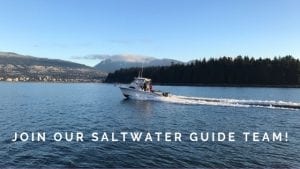 Do you want to fish every day but sleep in your own bed each night? Skip lodge life this summer and join the Pacific Angler Saltwater Guide Team! Check out all of the details here!
Do you want to fish every day but sleep in your own bed each night? Skip lodge life this summer and join the Pacific Angler Saltwater Guide Team! Check out all of the details here!
CLASSES AND COURSES
We’re already looking ahead to our March Classes and looking forward to getting in the classroom and out on the water with you all! If you missed our February Introduction To Fly Fishing Course join us in March. While our Winter Steelhead Course is full feel free to call the shop at 604.872.2204 and we can add you to the waitlist. If there is enough interest we may open up another date for the on the water portion of the course.
Tying Intruder Patterns – 2 spots left!
Steelhead fly fishing has been radically transformed in the past decade or so for two main reasons, Skagit style Spey casting and the Intruder style fly. This combination has proven to be absolutely deadly effective for catching steelhead. In this one night course you will learn about the specifics techniques and unique materials used to tie Intruder style flies. The way this type of fly is tied has evolved from the classic palmering style to a new composite loop style, and both techniques will be taught in detail in this course. In addition we will talk about why this style of fly is so productive and different ways to rig the fly from stinger hooks to the original Intruder rigging. At the end of this course you will have the skills needed to tie a variety of Intruder style flies from multi stage, monster flies for high water, average sized flies for everyday conditions, down to small, mini intruders for low water. Note that this course is suitable for intermediate to advanced tiers. Course materials are not supplied but can be purchased at the course night or in advance at 10% off. A detailed list of what materials are needed will be supplied in advance of the course.
Cost: $50.00 + GST
Dates: Mar 4, 2019
Time: 6:30pm – 9:30pm
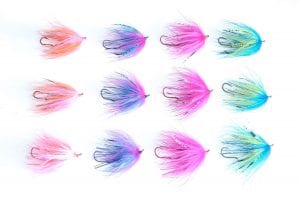 WINTER STEELHEAD ON THE FLY – Sold Out – call the shop to join the waitlist!
WINTER STEELHEAD ON THE FLY – Sold Out – call the shop to join the waitlist!
Fishing for winter steelhead on the fly (single hand or Spey) is arguably one of the most challenging and rewarding fisheries in BC. Let our steelhead gurus help you unlock the mysteries of these magical fish with their decades of steelhead guiding knowledge. This course consists of a 3hr evening seminar and 1 full day of guided fishing on the water. In the seminar we will go over rods, reels, lines, sink tips, flies and reading water and swung fly techniques. The fully guided day on the water we will be work on casting, reading water and swinging the fly.
Cost: $275.00 +GST
Dates: Seminar: Mar 6 Guided: Mar 9 or 10
Seminar Time: 6:30pm – 9:30pm | Guided: Full Day
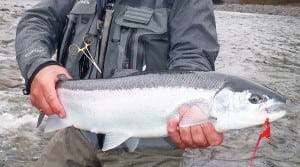 Introduction To Fly Fishing
Introduction To Fly Fishing
This course was specifically designed to give the new fly fisher the basic knowledge, casting skills and fly fishing strategies to effectively fish our local BC waters.
This course is comprised of two sessions a 3hr evening seminar and a 3hr casting session.
Cost: $150.00 + GST
Seminar: March 12, 2019 | 6:30pm – 9:30pm
Casting: March 17, 2019 | 10am – 1pm or 1:30pm -4:30pm
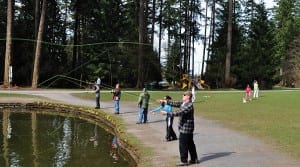 FEATURE
FEATURE
Fat Fry vs. Skinny Fry Patterns
(Yes, we could have come up with a more creative name but all our ideas were not politically correct)
So, there is a constant debate in the shop on what style of fry patterns works best. Andre, our resident commercial fly tying maestro has been tying his famous “skinny” fry patterns for years and they have caught thousands of fish. We stock them in a range of colours and sizes to match the given fry where you are fishing.
On the other end of the debate Matt and Zach love fishing a “fat” style of fry pattern. Over the last couple years of discussion the guys finally came to the conclusion that there is no “best” style and you actually want to have both styles in your box for different conditions.
The skinny fry are “best” in clear water especially when it is a little slower than walking speed. The smaller profile is harder to see and it gives the fish less time to inspect them before for committing to a strike. Right now when the Squamish is low or you are fishing the slew fisheries (Harrison, Stave, Fraser) the Skinny Fry is the first fry all the guys will go for in their fly boxes but when we are targeting Char species in coloured water we love to go to the Fat fry first. It is amazing how one will completely out fish the other on a given system or in a given condition.
Check out Zach’s Fat Fry and Andre’s Skinny Fry in the pictures below. We’ve included the materials list for the Fat Fry below. Come down to the shop if you have questions about how to tie this or if you have any other questions! We’re here to help.
Fat Fry Materials List
Hook: Mustad L87-3665A Size 10 or 8 (any 5-7 x-long shank hook will do)
Thread: 70 Denier White
Body & Tail: Antron White, Pearl Krystal Flash, Olive Krystal Flash
Eyes: Tape Eyes Small Silver
Other: Red, Neon Blue Sharpie, Solarez Thick, Thin and Bone Dry.
FRESHWATER FISHING REPORTS
Chilliwack/Vedder River Fishing Report
We heard some very encouraging reports from last weekend on the Vedder with a good number of anglers getting into some action. This is about the right timing as historically around mid February we see a good bump of steelhead. The water is still quite low so the fish are starting to stack up; they are throughout the system but it is important to find these holding spots so keep moving until you start seeing some action. There has been a lot of fishing pressure recently so make sure you bring different presentations with you and to switch it up if you are working behind other anglers.
It looks like we will be getting some warmer weather in the first week of March so we might get some higher and dirty water once the snow starts to melt. We are reaching peak season right now so get out there and put some hours on the river.
Alex Au-Yeung
Squamish River Fishing Report
The Squamish River and its tributaries have continued to be tough, but anglers are finding fish. Covering lots of water is key, and scaling back presentations is a must.
As we get closer to March and April, many anglers are starting to think of the fry hatch. This is a great fishery for lighter rods, including both gear and fly.
These fry are easily imitated with small fry patterns such as Andre’s famous epoxy fry, as well as small Dick Nites or Crocs. Having a variety of colours to match the dry is also key, so stock up and get ready!
Jordan Simpson
Stave River Fishing Report
We’re looking at some odd weather over this weekend. With the possibility of snow (more likely rain) playing into your weekend plans you may wish to stay a bit closer to home to itch that fishing scratch. Although you’re likely not going to get into a steelhead on the Stave, there is a healthy population of cutthroat and whitefish in the system, which are an absolute blast on smaller gear and this time of year it is quite possible to hook into the steelhead as well.
Whether it be your ultralight spinning rod or a wicked 2-4wt fly rod, the presentations are going to be pretty standard. On the gear side, pull out your Dick Nites and Mini G’s for both the cutties and whitefish. As far as fly fishing goes, try some of the more interesting wooly bugger and attractor patterns in your kit. It’s a great system for trying out some different techniques you’re not quite used to. Remember to dress warm!
Aidan Munro
SALTWATER FISHING REPORTS
Vancouver Saltwater Salmon Fishing Report/DFO PROPOSED MANAGEMENT MEASURES
Here is the quick winter chinook report. The fishing has been consistent in the Harbour and in Howe Sound, much like the last few reports, but there are much more pressing matters to discuss, so read on…
We have received a lot of calls these past 2 weeks about some of the proposed management measures for chinook in 2019. This is a complicated issue so I am going to do my best to explain it succinctly as well assist you in actions you need to take in order to preserve your recreational access to these fish. I know we are all very busy, but if you want to fish for chinook this year you best keep reading, read the DFO letter in the link, and write your own letter to DFO.
First a bit of background as there are a variety of chinook types, so bear with me. Some spend 2 years in river before they leave for the ocean and some spend very little time in river as they leave the same year they hatch. Some chinook live in our local waters, while others hang out off the West Coast of Vancouver Island, while yet others go much further afield. So as you can see, the life history of chinook is very diverse. Each river and its specific environmental conditions and subsequent chinook population is unique. As you can imagine, some are doing well while others are facing significant challenges. Some real life examples were seen in 2018 where there were very strong returns of chinook on the Cowichan River and Puntledge River while at the same time certain Fraser River chinook stocks had very low returns.
So how do we manage different populations of chinook in order to provide access to the recreational angler for the healthy chinook stocks, yet protect the weaker chinook stocks? That is a complicated scenario, but there are answers. DFO does have the data to know the when and where of chinook interception from all user groups including commercial, recreational, and First Nations. From here they do their best to come up with a management policy to allow sustainable harvest of some chinook stocks while protecting others. It is a very difficult and unenviable position to be in, especially in regards to Fraser River chinook stocks that spend 2 years in the river (known as 4.2 and 5.2) that are not responding well to current environmental conditions.
So that leads us to where we are today and I encourage you to read this document – DFO Chinook Management Approach Letter – so you can understand the current situation in detail and how it might affect your opportunities to sport fish. Keep in mind that this document is intended to communicate the Department’s approach for developing fisheries management actions to address conservation concerns for Fraser River Chinook in 2019. I want to specifically point out this is not a document where you need to choose Scenario A or B, as frankly neither are very desirable in my humble opinion. What you do need to do is write a letter to DFO telling them how important sport fishing for chinook is to you both socially and economically. Your letters are having an impact, and we need to keep them coming.
Letter Guidelines:
- Begin by describing your connection and history with the fishery. Are you a business? Are you a local angler? Is fishing part of your family traditions? Do your children enjoy fishing? Do you fish for food?
- How does angling activity impact your life and your family?
- If you are a business, how many people do you employ? How long have you been active in the community? How dependent are you on fishing?
- What will be the impact of scenario “A” on your business, employees, family and community? Don’t be afraid to use powerful language, but never resort to foul language.
- Do not recommend scenario “B”. Focus on the impact of scenario “A”. By choosing scenario “B” you will limit our ability to improve upon it. This will be especially important for anglers in the Juan de Fuca and Georgia Strait.
- Restrict your letter to just one page.
- Talk to your friends and associates and encourage them to send letters!
Key Messaging regarding the BC sport fishing sector (2016 data):
- $1.1 billion in annual sales
- $398 million GDP contribution to BC
- 9000 jobs resulting in 3950 person-years of employment
- The public fishery is the single largest economic driver of all BC fisheries, yet harvests less than 15% of halibut and 10% of salmon coast wide. It is estimated that the public fishery accounts for less than 4% of all fish harvested in BC.
Letters must be received by DFO before March 1st, 2019
Send them to:
DFO.PacificSalmonRMT-EGRSaumonduPacifique.MPO@dfo-mpo.gc.ca


